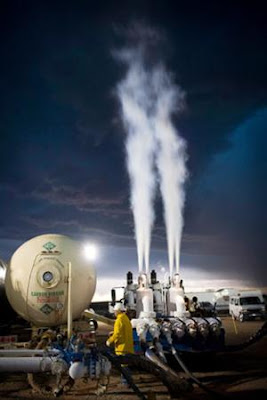The Eagle Ford Shale is located directly below the Austin Chalk Formation. The formation is about 50 miles wide and 400 miles long, extending from Texas’s southern border to the east. Eagle Ford is estimated to have reserves equaling more than 80 billion barrels of oil.
Oil and natural gas are posited in the following counties in south Texas:
- Oil: Atascosa, Wilson, Gonzales, Karnes, De Witt, McMullen and Live Oak counties.
- Natural Gas: Atascosa, Wilson, Gonzales, Karnes, De Witt, McMullen, Live Oak, Frio, La Salle, Duval, Bee, Bexar, Zavala, Maverick, Dimmit, Webb and Zapata counties.
via OilShaleGas.com
Cnooc Ltd. paid $1.08 billion for a one-third stake in Chesapeake Energy Corp.’s Eagle Ford shale project, the biggest acquisition of a U.S. oil and gas asset by a Chinese company (emphasis mine). via BusinessWeek
All this sounds great for the Texas economy, but it is truly bad for the air and water of Texas in these areas. Below is an excerpt from Fact Sheet: Hydraulic fracturing should be regulated under the Safe Drinking Water ActHydraulic fracturing involves the injection of fluids, often containing toxic chemicals, into oil or gas wells at very high pressure. These pressurized fluids are used to crack open the underground formation to allow oil or gas to flow more freely and increase production. Studies show that, while some of the injected fluids are returned to the surface, some remain underground. In some cases, they are injected directly into underground sources of drinking water. . .

Rivers recharge aquifers and over 90% of the population in rural Texas get their drinking water from groundwater. In certain areas of the country, you cannot drink the water flowing from your tap. Here is just one story and it takes place in Canada:
On Christmas Eve 2005, Fiona Lauridsen and her three children got chemical-like burns after taking showers in their home. Tests showed higher than normal levels of methane gas in their water coming straight from the aquifer, along with the presence of man-made chemicals. , , ,This is not any unusual when you drill or frack in a populated area. However, for more information, please see the blog, Bluedaze: Drilling Reform for Texas. TxSharon has been tracking oil shale problems in northern Texas and other states.
Remain civil, but TAKE ACTION.



1 comment:
Ah, I was just having a conversation about this with a friend the other day. She was trying to tell me that fracing was safe. Ha!
Post a Comment